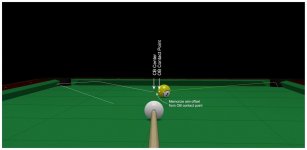Based on some of the comments in this thread it might be worth reviewing the difference between fractional aiming and pivot aiming, IMO. Boiling it down to its essence:
In fractional or traditional aiming you have one straight stroke and many, many aim points.
In pivot aiming you have a very small number (say 3 or 5) fixed aim points and many, many pivot adjustments.
A well known CTE user told me that if you don't have any problem imagining a ghost ball then there is no need for CTE. He prefers to aim at a point on the ob and then use his experience to tell him how much to pivot.
The two methods are simply two sides of the same coin. Nobody has ever said that pivot systems don't have merit. It is just that some people oversell or misunderstand what pivot systems actually provide the player.
sacman is a great example. I'm happy for him that he found something that suits him and he should continue to pursue that avenue. However, his success not a result of a system that takes judgment and rote learning out of the game.
In fractional or traditional aiming you have one straight stroke and many, many aim points.
In pivot aiming you have a very small number (say 3 or 5) fixed aim points and many, many pivot adjustments.
A well known CTE user told me that if you don't have any problem imagining a ghost ball then there is no need for CTE. He prefers to aim at a point on the ob and then use his experience to tell him how much to pivot.
The two methods are simply two sides of the same coin. Nobody has ever said that pivot systems don't have merit. It is just that some people oversell or misunderstand what pivot systems actually provide the player.
sacman is a great example. I'm happy for him that he found something that suits him and he should continue to pursue that avenue. However, his success not a result of a system that takes judgment and rote learning out of the game.
